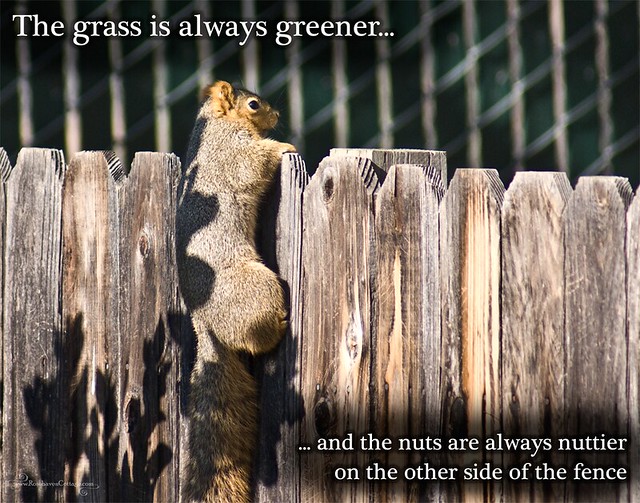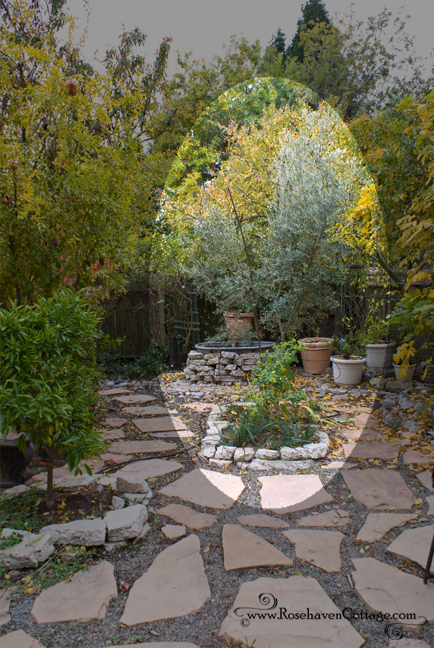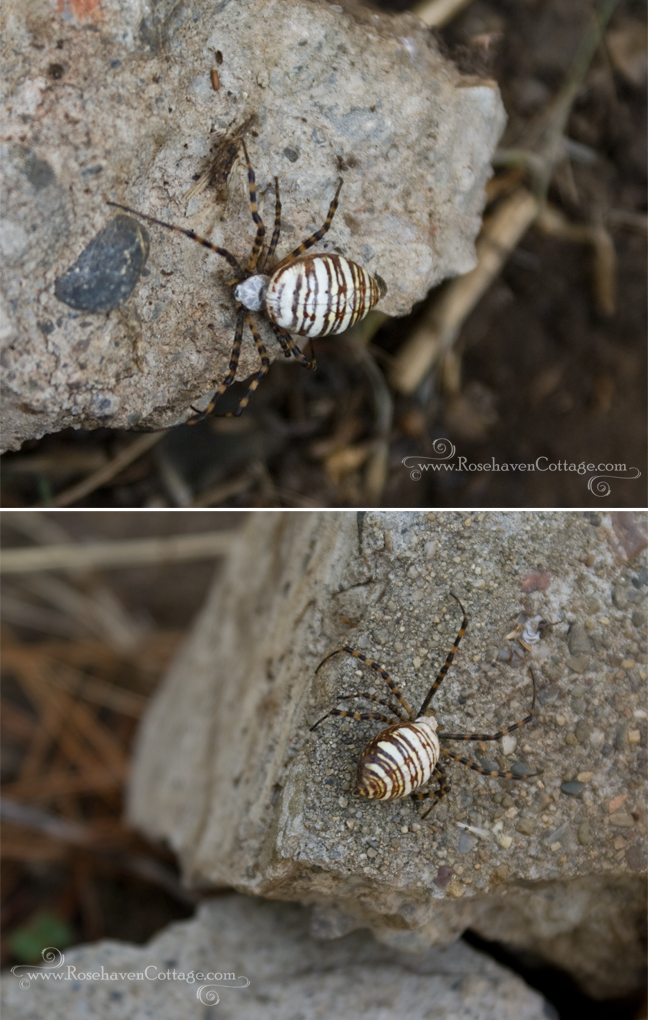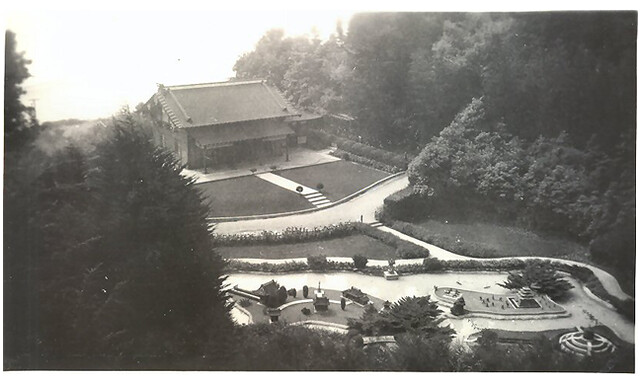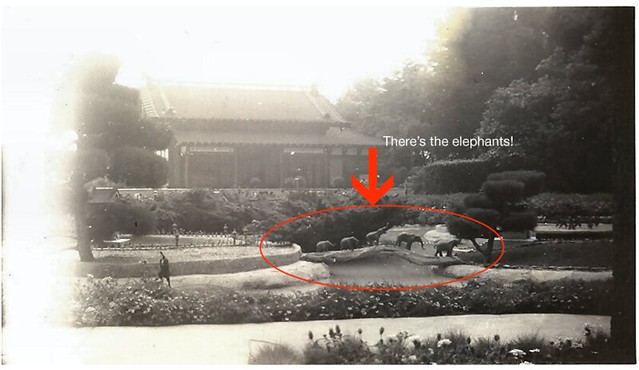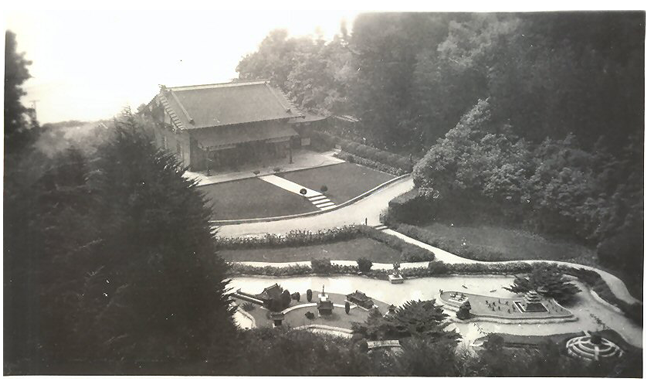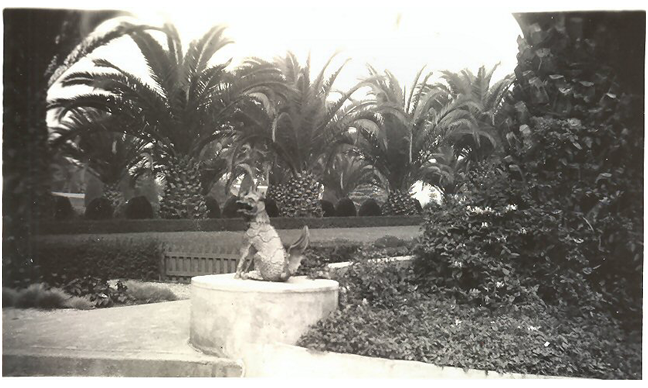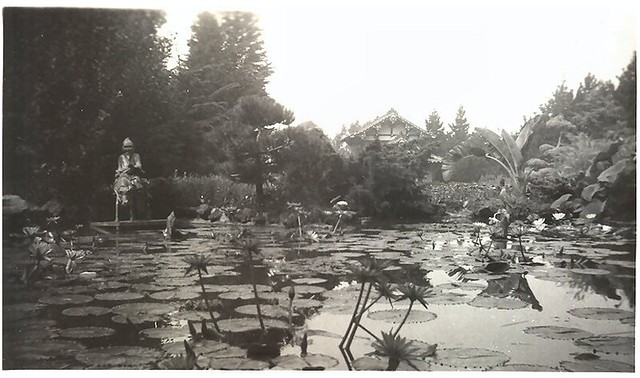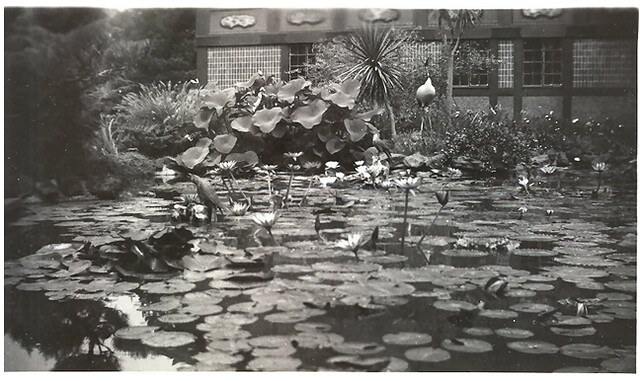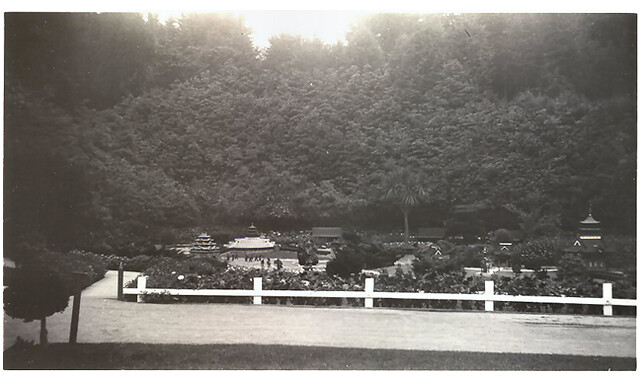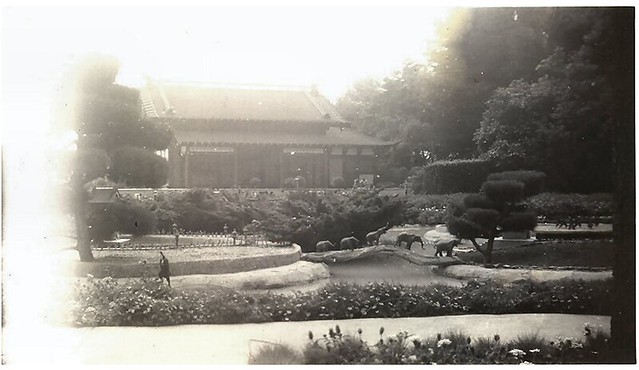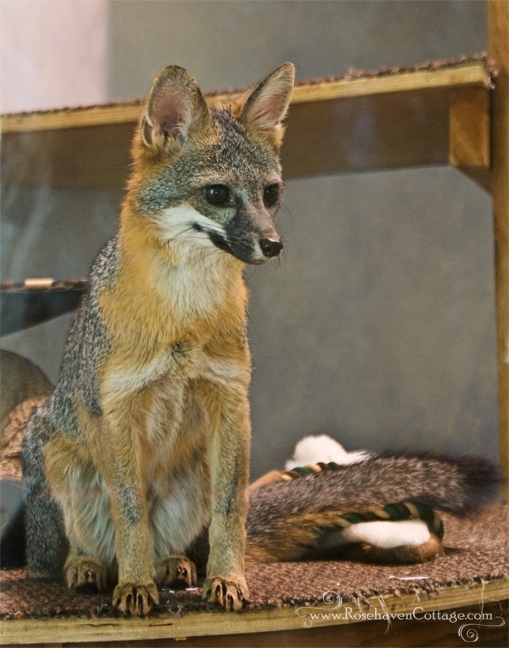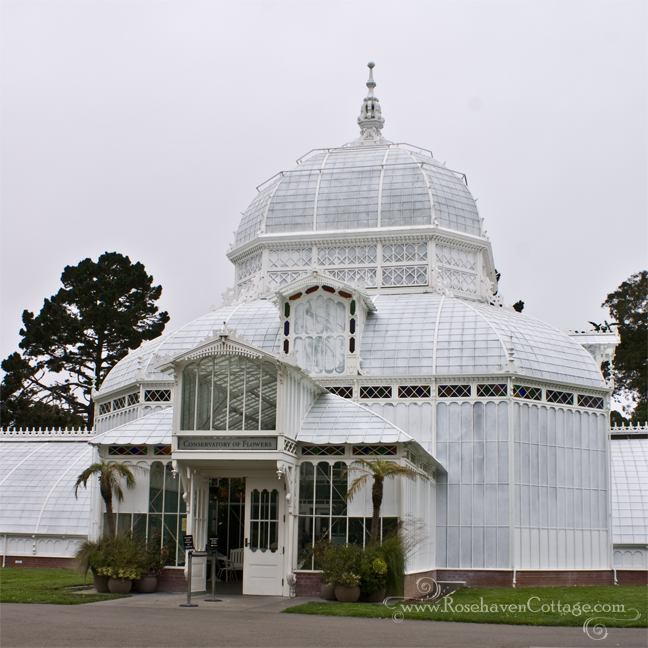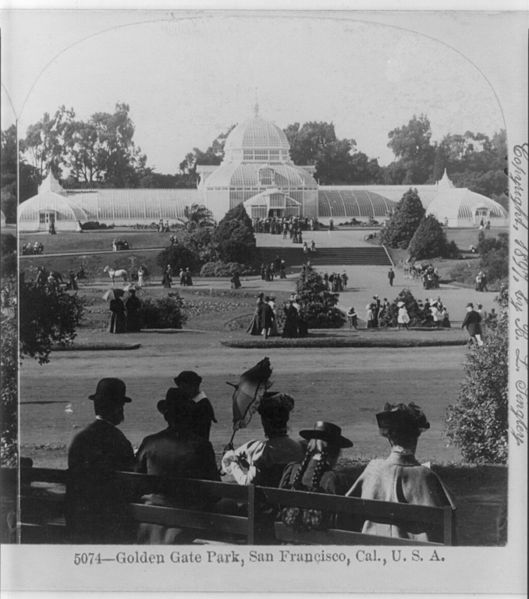I finally got a photograph of a woodpecker in our garden thanks to a cantankerous squirrel
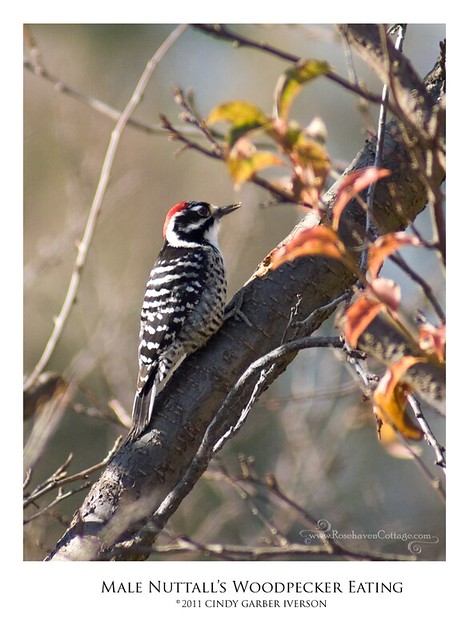
Maybe for other people getting a photograph of a woodpecker isn't such a major feat but for me it's HUGE! Over the past 11 years, I've heard woodpeckers in our neighbors' trees. I've tried to follow the sound to catch a glimpse of them. But the woodpeckers around here are very elusive, and the glimpses I've gotten are fleeting. Photographing them seemed impossible.
Today, I went out to catch some sun on our deck and brought my camera with me (something I usually don't do when catching rays). The usual birds were flitting about and eating the seed I put out yesterday. Several squirrels were helping themselves to the sunflower seeds I put out for them.
Then in my peripheral vision I saw a red flash on the trunk of the neighbor's pine tree. I turned and focused my attention and saw a male Nuttall's woodpecker casually pulling bugs from the cracks in the bark and eating them. I couldn't believe it! I focused my zoom lens and started shooting.
But it wasn't long before Mr. Woodpecker, was joined by one of the squirrels that had been dining in my garden. The squirrel stood on the tree, suspended head down, for quite some time just calmly observing Mr. Woodpecker. The woodpecker didn't seem bothered and continued to eat as if the squirrel wasn't there. All seemed right with the world...
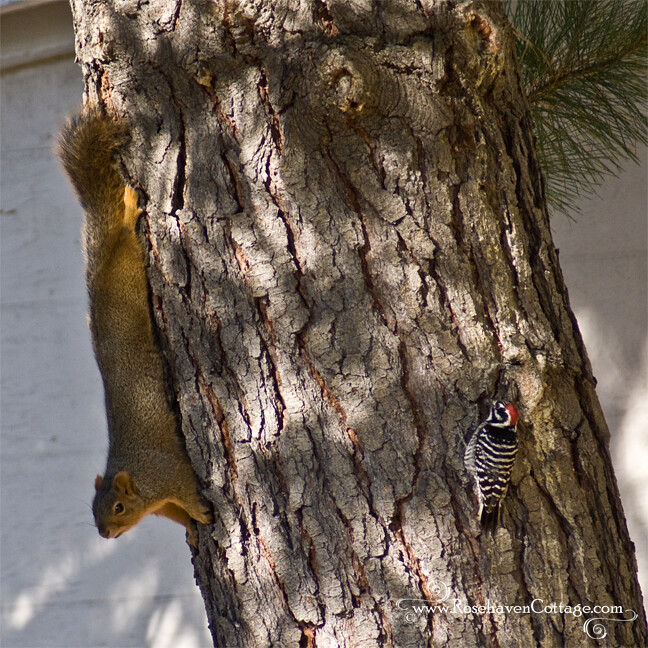
...until another rotten-tempered squirrel came down from the upper branches of the pine tree having made up its mind that the tree belonged to him!
Mr. Woodpecker gave the two squirrels a glance as the cantakerous squirrel chased the other benevolent squirrel down the tree trunk. The two squirrels quickly looped back up the trunk and Mr. Woodpecker was forced to hop out of the way as the chase blasted over his dining spot.

The squirrels seemed to have continued the chase onto the ground, so Mr. Woodpecker started to settled into a new spot to eat...

... but the crabby squirrel, having evicted all other squirrels from the tree, came back up the ready to evict all other species as well.
Mr. Woodpecker had had enough and flew away.

I was disappointed. I thought my opportunity to get a decent shot had passed until I realized that the squirrels had done me a favor. Mr. Woodpecker flew into our garden and landed in the Santa Rosa plum tree next to the pond. In full view of my zoom lens, he commenced finding bugs again. I couldn't have asked for a better vantage point to watch and shoot. The squirrels and their shenanigans had created a moment of photographic serendipity in more ways than one.

Our olive tree "Miss Olive" produced her first olive
Tucked into my favorite part of the garden with bearded and native Pacific Coast iris growing at her feet, "Miss Olive" has been slowly growing and growing. She's an OLEA europeaea of the Manzanillo variety ("the olive of Seville"), so we've known that she needed to be at least 7-10 years old before she will begin to produce fruit.
Ever since I read the The Olive Farm: A Memoir of Life, Love, and Olive Oil in the South of France by Carol Drinkwater, I've dreamed of growing and harvesting my own olives to make citrus-infused olive oils. When I read the book aloud to Hubby while on a road trip, he too shared that vision. We went to our local nursery, picked out Miss Olive and brought her home to become a part of our gardens. Because Miss Olive is adopted, we've never known how old she really is in order to chart when to expect olives.
Each spring since she got settled in, she's produced tiny little blossoms. I've watched them throughout each summer to see if any turn into fruit, mostly expecting that none of them will.
This year was the same.
But today when I was making the rounds checking on the garden before the rains blew in from the west, I walked past Miss Olive and a small black orb dangling in my peripheral vision caught my attention. I could hardly believe it, but it was indeed an olive!
Now we can finally officially begin to chart Miss Olive's progress toward her peak production years when she's 30-70 years old. By then, she will produce an average of 88 lbs. of olives a year (in good years as much as 150-200 lbs.). Manzanillo olives are traditionally a table olive because they produce less oil per olive and aren't economical for mass production. But the oil from a Manzanillo olive is of a fine quality and will be wonderful for our own personal production and use.
I guess it's time to start saving for the olive oil press I've had my eye on for a few years now.

The buddleia provides a rest stop for a migrating butterfly
A very large buddleia (butterfly bush) grows in the front garden with its upper branches as high as the house. Every year around August, I give it a haircut and it responds by putting on an encore show of lovely sweet blooms late in October or early November.
This year the blooms provided a meal for a Painted Lady butterfly. The sweet nectar must have been a welcome rest stop snack for this tattered and tired lady as she was flying by during her autumn migration. Painted Lady butterflies migrate in the spring and again in the autumn.
When I see one of these beauties in its post-summer migration south I wonder where it must have spent the summer months. Did this lady enjoy breezy summer afternoons flitting over meadows of wildflowers in the Sierra Nevadas so dear to my heart?
I hope she did.

I discovered I have my very own "Charlotte" spider in my garden
Years ago, on a drizzly autumn day in November we encountered a very fancy looking largish spider out in the garden. We'd never seen one before. We took photos of it. And then we spent the next several years wondering what kind of spider it was.
While out in the garden on Monday, I finally encountered another one. With her backend measuring about 1/2 inch in length she was hard to miss as she moved through some weeds that I had just cut down. I didn't have my camera with me, but studied her for quite some time so I could go inside later and use the internet to finally make a positive indentification.
Thanks to www.InsectIdentification.org I finally identified her species. She's a banded garden spider!
Today, I was back out in the garden working in the same general area and spotted another one (or maybe the same one). This time I went in and got my camera. I'm glad I did.
Here's some interesting facts I found out about this elusive spider:
- Banded garden spiders (Argiope trifasciata) start to appear during the Autumn when temperatures start dropping
- They are orb-weavers that produce large conspicuous webs amongst shrubbery and vegetation
- They can weave a web 2 feet in diameter
- Just like Charlotte's web in Charlotte's Web, the banded garden spider's web is very concentric--the quintessential spider's web
- And also like in Charlotte's Web, banded garden "spiderlings" get around by "ballooning"--being carried on breezes that catch the silken threads the spiders produce
- Banded garden spiders are a great predator to have in your garden because their webs catch lots of flying insects that you don't want

The autumnal red of leaves turning
What is it about the autumnal red of leaves turning?
Hubby and I were driving to the nursery to look at pots yesterday. We rounded a bend in the road to see a stand of trees with the topmost leaves brilliant and bright red. It made us both gasp in a bit. My finger pointed reflexively at them, and I could feel that Hubby had unconsciously lifted his foot off the accelerator to slow just a bit as we drove by.
Why does the red of autumnal leaves make us do that... make us act like little children again?

'Tis the season of pineapple sage blossoms and hummingbirds
All summer long the pineapple sage (Salvia elegans) grows without blooming. As a perennial in our climate, summer is its time to finish growing back from the annual "haircut" it gets in January or February when I cut it back almost all the way down to the ground. This bush has been in the ground for about 10 years and does better with the severe once-a-year prune as opposed to lighter more frequent pruning.
In autumn, when the rest of the flowers in the gardens have faded and fallen, the pineapple sage puts on its show. Dazzlingly bright scarlet trumpet flowers bloom and adorn the bushes from mid-October until often well into holiday season between American Thanksgiving and Christmas. In years past I've cut large sprigs off to decorate my Thanksgiving table.
This year, I tried growing pineapple sage in a pot on the deck outside my studio window, so I'd have hummingbirds there too like I used to before the deck was constructed a couple of years ago. The bush in the pot struggled throughout the summer but bounced back in September and is blooming nonetheless.
The pineapple sage comes by its name honestly. If you crush a leaf in your hand and hold it to your nose you can smell the tropical sweetness of pineapples.
The blooms must also be full of sweetness because the hummingbirds love them. Many a fight breaks out in the air over the pineapple sage as our Anna's hummingbirds refuse to share the bounty nicely.
This little gal didn't have to share this afternoon. Lucky her.

In only a couple of hours the mystery has been solved!
I just LOVE technology! In a matter of hours, one comment from one person solved a mystery that's been bugging me for years (see the post below or click here to read it).
Thanks to Elaine I now know that this photo is of the Bernheimer Oriental Gardens in Pacific Palisades, California.
Once Elaine gave me a name, I was able to do a quick Google search and I found the following photograph at CardCow.com
Those elephants are definitely the same statuary in the photograph taken by my grandmother (below).
From www.image-archeology.com:
Bernheimer Residence and Oriental Japanese Gardens
Pacific Palisades & Hollywood, California
It looks like Hubby and I won't be taking any road trips to see this beautiful landmark. We're both sad that it no longer exists.

Want to help solve a mystery? Identify the California landmark in these photos from the 1930s
My Grammy was quite the shutterbug. And, for the most part, she was really good about organizing her photos chronologically in nice neat photo albums (you know the kind with the thick construction paper pages and photo squares to secure the corners of the photos). In the late 1930s, as a single woman in her 20's she did a few road trips that she documented photographically and then put into a small album that surfaced a few years ago.
Here's where the mystery comes in...
She failed to label one section of photographs in the little album and I have no idea where they were taken.
Here's what I do know:
- The photos are definitely from one particular road trip.
- Based on proximity to other labeled photos and the ages of the people in the photos the trip happened around 1937-1939.
- She took the trip with her widowed father and kid brother. The destination appears to have been Sequoia National Forest based on the photo below (the sign says, "Boundary Sequoia National Forest").
- The road trip started in Oakland, California. I know from the photo above that they definitely visited the Sequoia National Forest in central California (see the map below) while on the road trip.
- The Asian gardens in the photographs I've included in this post must have been located somewhere in central or southern-central California.
- The first photograph (above) looks like the gardens may have been along the coast of California.
- The sub-tropical plants in the photos of the Asian gardens indicate that the elevation isn't high enough for the climate to get a lot of winter frost and probably not any snow.
Can you help solve the mystery? Does anything in these photographs look familiar?
I would love to know if these gardens still exist, so Hubby and I could take our own road trip to visit them. The statuary in the photographs is amazing. I wonder if any of it still exists.
Look at the elephant statuary crossing the bridge (below)

Meeting Mr. Gray Fox
This handsome fellow was found by humans in their barn when he was a young orphaned kit (or pup) and tried to raise him on their own. But the well-meaning humans found that raising a wild animal is something better left to professionals when the fox got sick after a few months. That's how the fox came to the Lindsay Wildlife Museum where he was rehabilitated. But because he had been orphaned so young he hadn't learned the ability to hunt in the wild from his parents, so he couldn't be released back into the wild. When injury or circumstances preclude the optimal release back into the wild that is the goal of most rehabilitated animals, Lindsay Wildlife Museum makes a permanent residence for the animal in their educational facility where the animal can become an ambassador for teaching people of all ages.
Mr. Gray Fox is one of the museum's most popular ambassador right now. He's only a couple of years old so he has a long career ahead of him (he'll most likely live to be 12-14 years old in captivity).
We sat and watched Mr. Gray Fox for about an hour as he excitedly anticipated feeding and "training" time (which we were also able to watch). We were fascinated by his beauty and memorized everything about him. It was the first time we had seen a gray fox, so Mr. Gray Fox was definitely doing his educational ambassador job with us.
A week after our educational visit, Hubby and I came home late in the evening from being out. We pulled into our driveway, and Hubby got out of the truck to retrieve our recycling, green waste and garbage cans from the curb. As he did so, he saw an animal that he mistook for a neighborhood cat at first. It crossed from our neighbor's yard across the street less than 10 yards from where Hubby stood. Because of our educational experience with Mr. Gray Fox at the Lindsay Wildlife Museum, Hubby realized that the animal wasn't a cat. It was a gray fox!
Hubby slowly walked to where the fox had headed into our next door neighbor's driveway and had disappeared from view behind our jasmine hedge. As Hubby rounded the corner of the hedge, the fox trotted back out toward him across our narrow country-lane-of-a-street, then zig-zagged back across to our side of the street again to our other next door neighbor's yard. All the while Hubby was standing in the middle of the fox's zig-zagging getting a perfect view of this incredible creature that humans rarely see the in wild because of their shy nocturnal habits.
When the sighting finally ended with the fox disappearing into the neighbor's yard, Hubby called out to me (I was still up by the house) in a loud whisper, "I just saw a gray fox!" He was so excited. And so was I when he recounted the sighting to me. I wish I hadn't missed it.
We are thrilled that after 11 years here at Rosehaven Cottage, we finally witnessed a gray fox living here. We hope it has frequented our own backyard wildlife habitat and not just our neighbors' yards. The gray fox is the only member of the canine family that climbs trees, and we have some of those for it to climb during the night-time hours when it hunts. Hopefully, it hunts in our garden and helps itself to some rodents. Our garden wildlife habitat is small by most standards but the "welcome mat" is always out.
A helpful tip from the Lindsay Wildlife Museum's "Living With Wildlife" information:
Prune trees and shrubs between October and December
In Northern California and other temperate areas of the United States, some birds and mammals begin nesting in January. The nesting season lasts into August. When you prune trees and shrubs during those months, check carefully for nests and be sure any babies are gone before you prune. The safest time to prune is between October and December.
(Insider info: My garden and produce are healthier and happier
since I started gardening for wildlife)

Thank you, Mr. Jobs
On January 24, 1984, this happened...
My world changed that day.
At first I wondered where the C:\ was (otherwise called a "C prompt"). I wanted to enter basic DOS commands to make the computer do tricks like the ones I'd played with at school. I was frustrated and thought this "toy" wasn't worth much if I couldn't interact with it and make it loop with some simple BASIC code. This couldn't be a true computer if it didn't have that C:\. My younger siblings were less jaded than I and immediately loved the Mac. I took a few days to embrace it.
I didn't know that I was in a unique position. I was 17 years old--old enough to embrace technology but not so old that it intimidated me. I didn't realize that the little box without the C:\ was going to change my world (and everyone else's too). I was going to be one of only a relatively few of the world's population that straddle the transition between life before the Mac-led PC revolution and after.
I became an early adopter by default. When the first version of Microsoft Word was released (originally for the Mac), I learned it so I could work at temp jobs during my breaks from college. When the first version of Microsoft Excel was released, I did the same. When on one of those temp jobs an employer handed me a box and said, "No one has time to learn this. Can you?" I took it and taught myself the first version of Adobe PageMaker and entered the world of desktop publishing.
I graduated with a two-year degree in Commercial Art having received all my graphic design training without touching a single computer. My fellow students and I were probably one of the last groups to do that. I was learning how to do layout using "old school" techniques with t-squares and waxed paper bits. All the while I was creating with the Mac on the side knowing there was an easier way to do things.
It doesn't seem that long ago.
As I sat here today in front of my beautiful trusty iMac with its gorgeous display that lets me post-process digital photographs with the utmost color accuracy, I reflected on all the ways that Steve Jobs' vision of the Mac and his passion for pushing the limits of technology has touched my life. It was very hard to contain the emotions that welled within me from the gratitude I felt for someone being willing to tenaciously push forward despite multiple setbacks, the odds being stacked against him so many times, and the voices of critics on all sides.
Thank you Steve Jobs for continuing to believe in your passion. Thank you for following that inner drive that pushed you to see what others couldn't. I thank you with tears in my eyes and the fullest heart.
It is because of you, Mr. Jobs, that I can sit here in the comfort of my home studio and be a creative professional today. It is because of that little box without a C:\ that I can do things I couldn't have dreamed of doing back on that day in 1984.
My world changed again today... because my world had to say goodbye to you.
Steve Jobs 1955-2011

A visit to the Conservatory of Flowers... like a trip to Hawaii without the cost of airfare
Sitting like a white palace in Golden Gate Park is a magnificent building--the Conservatory of Flowers. Constructed in 1878, it has been there for a very long time. The building strikes me as a "she" for many reasons. She has survived a major fire in 1883; the horrific San Francisco earthquake of 1906; another fire in 1918; and devastating windstorms of 100 mph shattered the 30,000 glass panes and the glass dome in the winter of 1995-1996.
I'd say that sort of tenacity has to come from a "she" wouldn't you agree?
She reminds me of many of the women in my family that lived in the San Francisco area at the same time the Conservatory of Flowers was built.
For years after the catastrophic winter of 1995-1996, the Conservatory sat in a state of restoration. Whenever I would be driving through Golden Gate park I would wistfully look at her and wonder what she looked like inside. Fortunately, after a masterful restoration she is open to the public once again. And like any elect lady, her true beauties are within.
Stepping into the first of five separate climate rooms, I was enveloped with the warm moist tropical air of the Lowland Tropics room housed under the main dome. It was chilly outside so my glasses and camera lens fogged up right away. But once everything got acclimated, it was time to explore.
Stepping into the next annex, I found myself in the cool humidity of the Highland Tropics where more than 700 of the 1000 known species of high-altitude orchids native to Central and South America happily reside.
Then stepping through another set of double doors I was enveloped by warm moist air even denser than in the Lowland Tropics room. The Aquatic Plants room showcases a massive pond in the center with a breathtaking array of aquatic tropical plants growing within it.

Some pale blushing anthuriums were one of many tropical flowers growing around the pond.
Tracking back through the rooms and exiting the Lowland Tropics room on the opposite side, I found myself in my favorite room--the Potted Plants Gallery. Fashioned after what garden historians have termed the "Victorian Pot Culture", the room made me feel as if I had stepped back in time 100 years.
The above image (or other media file) is in the public domain because its copyright has expired.
Stepping into the next annex, I found myself in the cool humidity of the Highland Tropics where more than 700 of the 1000 known species of high-altitude orchids native to Central and South America happily reside.
Then stepping through another set of double doors I was enveloped by warm moist air even denser than in the Lowland Tropics room. The Aquatic Plants room showcases a massive pond in the center with a breathtaking array of aquatic tropical plants growing within it.

Some pale blushing anthuriums were one of many tropical flowers growing around the pond.
Tracking back through the rooms and exiting the Lowland Tropics room on the opposite side, I found myself in my favorite room--the Potted Plants Gallery. Fashioned after what garden historians have termed the "Victorian Pot Culture", the room made me feel as if I had stepped back in time 100 years.
Hubby and I sat for quite some time in this gallery on the large curved bench at one end. It was peaceful and serene. It felt like a home away from home. During certain times of the year this gallery's air is pungent with citrus blossoms, but on this particular day the air was only laced with the aroma of fresh soil and the smell of green life... and it felt like home.
More facts about The Conservatory of Flowers (from Wikipedia):
- The building remains the oldest in Golden Gate Park and is the oldest municipal wooden conservatory remaining in the United States
- The central dome rises nearly 60 feet (18 m) high and the arch-shaped symmetrical wings extending from it on either side make up 240 feet (73 m) in overall length
- Physical evidence suggests that the Conservatory of Flowers was constructed originally of redwood milled on the West Coast

In a not-so-far-distant land...
On the edge of a very big city called San Francisco, is a misty magical forest.
And in the middle of the misty magical forest is a beautiful palace.
The palace is guarded by a lion.
The lion lies at the palace gates every day
and gazes out beyond the misty forest to the sea and the hills beyond the sea.
Through the mist, the hills on the other side of the sea
appear to be giant's toes dabbling in the waters.
The old lion thinks he is guarding the palace from the giant...
and no one tells the lion otherwise.
Just inside the palace gates,
one of the world's greatest thinkers sits and thinks very sage thoughts.
Inside the palace live many important people.
Courtiers converse with grand dames of elegance and refinement.
Queens grace the halls wearing their royal jewels and finery.
And despite the lion guarding the palace from giants that will never invade,
The world's greatest thinker pondering the universe,
And all the royalty walking and conversing with utmost refinement...

The palace cat must still endure all manner of indignities
at the sticky fur-grabbing hands of the palace tot.
All photos taken
at the Palace of the Legion of Honor museum of art
in San Francisco, California

Subscribe to:
Posts (Atom)

All images, photos and writing



